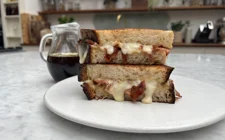THE COMPLETE GUIDE TO CREATING A PERFECT CHEESE BOARD
7 tips to styling and arranging your cheeses!
Keep it simple or release all your creative energy! Creating a cheeseboard can be as basic or as advanced as you like but one thing is for sure – the flavours, aromas, shapes and textures of the delicious cheese will ensure a great experience. Here are seven tips for arranging and styling your cheeseboard.
1. SELECTING CHEESES
When you select cheeses for a cheeseboard think of color, shape and texture. There are several types of cheese – cream cheese, hard cheese and mould cheeses ranging from subtle Double Crème White to a stronger blue mould cheese. It’s a good idea to serve at least 3-5 different cheeses and choose cheese from each type of cheese. Always have a mild cheese in your selection in case your guests are not as adventurous as you!
2. STYLING
Be creative when arranging your cheeseboard. Use interesting surfaces like a wooden cutting board, rustic tiles or a dark dish as contrast to the bright colors of the cheeses. Arrange the cheeses from mild to strong.
3. HOW TO CUT YOUR CHEESE
Yellow cheeses and hard cheeses can be cut into triangles, sticks or bricks. Brie, cut into wedges and blue mould can be cut into squares or wedges depending on the shape. A good tip is to heat up the knife in hot water before cutting the blue cheese. Add a knife or cheese cutter for each cheese so the flavours don’t mix.
4. SERVING SIZES
The amount of cheese each guest eats varies depending on the occasion.
Snack: 25-50g per. person
Dessert: 50-75g per. person
Lunch: 75-125g per. person
Dinner: 250g per. person
5. SERVING TEMPERATURE
Remove the cheese from the refrigerator 30 minutes before serving. This will bring out the full flavour of the cheese. The color of the blue cheese also intensifies when letting it breathe before serving.
6. PERFECT PAIRINGS
Cheese accompaniments should complement and not compete with the flavour of the cheese. Therefore, choose neutral accompaniments such as crackers, crisps or bread with a rustic crust. Apples, pears and berries always work well with cheese and provide a colorful touch to the cheeseboard. Try roasted hazelnuts and a little maple syrup for a sweet touch. Celery, dried fruit, cherries or grapes are excellent matches for a blue cheese.
7. CHEESE AND WINE
Cheeses are as unique and complex as wine and a cheese can really bring out the best in a wine. Always taste the cheese and then the wine; this gives you the best taste experience. For tangy cheeses such as goat cheese choose a fresh wine made from Sauvignon Blanc Grapes. Average strong hard cheeses and salty cheeses such as blue mould and hard aged cheeses go well with a glass of port.








